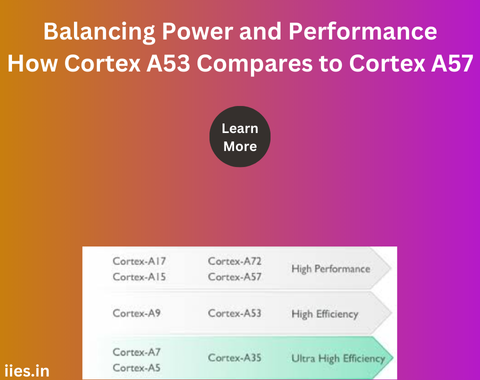1. Architectural Overview
Cortex A53:
The Cortex A53 is part of ARM’s Cortex-A50 series, known for its 64-bit processing capabilities. Launched in 2012, it was one of the first ARM processors to support the ARMv8-A architecture, bringing significant improvements over its predecessors. The A53 is designed with a focus on power efficiency, making it ideal for use in environments where energy conservation is crucial. Despite being a 64-bit processor, it maintains backward compatibility with 32-bit code, ensuring a smooth transition for applications that are not yet optimized for 64-bit.
The A53 utilizes a dual-issue in-order pipeline, which is relatively simple but highly power-efficient. This design choice allows the A53 to execute tasks with minimal power consumption, making it a popular choice for smartphones, tablets, and other battery-powered devices. Additionally, the A53 can be used in a quad-core or octa-core configuration, providing scalability for different performance needs.
Cortex A57:
The Cortex A57, also introduced in 2012, is positioned as a high-performance counterpart to the A53. It also supports the ARMv8-A architecture and 64-bit processing, but it is designed with a focus on delivering maximum computational power. The A57 is aimed at applications requiring higher processing capabilities, such as servers, high-end smartphones, and tablets.
The A57 employs a more complex out-of-order, triple-issue pipeline, which allows it to handle more instructions simultaneously and improve overall processing speed. This makes the A57 significantly more powerful than the A53 but also more power-hungry. The A57 is typically used in combination with the A53 in big.LITTLE configurations, where it handles more demanding tasks while the A53 manages less intensive operations.
2. Performance and Power Efficiency
Performance:
When comparing the performance of Cortex A53 and Cortex A57, the A57 clearly outshines the A53. The A57’s out-of-order execution pipeline and ability to issue more instructions per cycle translate into higher performance, especially in tasks that require significant computational power, such as gaming, video processing, and multitasking. The A57 can achieve higher clock speeds compared to the A53, further boosting its performance.
However, the A53, while not as powerful, offers respectable performance for most everyday tasks. It is perfectly capable of handling web browsing, social media, and other common applications with ease. For many users, especially those who prioritize battery life over raw power, the A53’s performance is more than adequate.
Power Efficiency:
The A53’s architecture is designed with power efficiency in mind. Its in-order pipeline, though less capable of handling complex tasks, consumes significantly less power than the A57’s out-of-order pipeline. This makes the A53 an ideal choice for devices where battery life is a primary concern. In contrast, the A57, with its more complex design, consumes more power, which can be a drawback in devices where energy efficiency is critical.
In big.LITTLE configurations, the A53 and A57 are often used together to balance performance and power consumption. The A53 cores handle less demanding tasks to conserve energy, while the A57 cores take over when high performance is needed. This approach allows devices to deliver both good performance and long battery life.
3. Use Cases and Applications
Cortex A53:
The Cortex A53 is widely used in budget and mid-range smartphones, where its power efficiency and sufficient performance make it an excellent fit. It is also found in a variety of embedded systems, IoT devices, and consumer electronics, where energy efficiency is crucial. Additionally, the A53 is often used in data centers and servers as a low-power processing core in environments where energy costs are a concern.
In the automotive industry, the A53 is used in infotainment systems and other applications where moderate processing power is required without sacrificing power efficiency. Its ability to run 32-bit applications makes it a versatile choice in environments where legacy software support is needed.
Cortex A57:
The Cortex A57, on the other hand, is typically found in high-end smartphones, tablets, and even some laptops. Its high performance makes it suitable for tasks like gaming, video editing, and running multiple applications simultaneously. In servers, the A57 is used in high-performance computing environments where processing power is prioritized over power consumption.
The A57 is also utilized in network infrastructure, where its performance characteristics are beneficial for handling large volumes of data and processing complex network functions. In automotive applications, the A57 can be found in advanced driver-assistance systems (ADAS) and other computationally intensive tasks that require robust processing power.
4. Scalability and Flexibility
Both Cortex A53 and A57 are highly scalable, allowing them to be configured in various ways depending on the desired balance between performance and power efficiency. The A53 can be used in configurations ranging from dual-core to octa-core, depending on the performance requirements of the device. Similarly, the A57 can be scaled up to meet the demands of high-performance applications.
The flexibility of these processors is further enhanced by ARM’s big.LITTLE technology, which allows the A53 and A57 to work together in a single system-on-chip (SoC). This approach provides a dynamic balance between power efficiency and performance, enabling devices to adapt to different workloads and extend battery life without compromising on processing power when it’s needed.
5. Future Outlook and Advancements
As ARM continues to develop new processors, both the A53 and A57 remain relevant in various applications. The A53, with its emphasis on power efficiency, will likely continue to be used in devices where battery life and low power consumption are critical. Its role in IoT, embedded systems, and entry-level smartphones is expected to persist as these markets grow.
The A57, while now surpassed by more advanced ARM processors like the Cortex A72 and A76, still holds a place in high-performance computing environments. It may continue to be used in older devices and systems that require its specific capabilities, particularly in markets where upgrading to newer processors is not immediately necessary.

